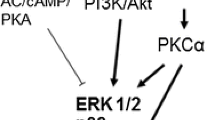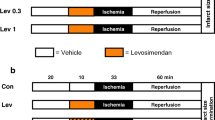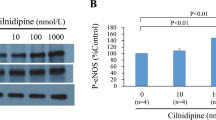Abstract
Mepacrine (quinacrine) has in a number of studies been shown to protect the heart from ischemic injury, a protection commonly claimed to be due to inhibition of phospholipase A2. The aim of the present study was to investigate the effect of mepacrine 1 μM on isolated, buffer perfused rat hearts subjected to 60 min hypoxia and 30 min reoxygenation. We also wanted to clarify whether any cardioprotective effect was due to inhibition of phospholipase A2 or to other effects of the drug. Mepacrine led to a substantial fall in left ventricular developed pressure (LVDP) and coronary flow (CF) during normoxic perfusion. Treated hearts showed less increase in LVEDP and less fall in LVDP during the hypoxic period, and significantly fewer hearts stopped beating compared to untreated controls. Release of CK during hypoxia and reoxygenation was reduced in treated hearts compared to controls (19.9±3.8 vs. 73.1±13.3 IU, p<0.05). Lipid analyses of the myocardium showed a significant increase in the total amount of non esterified fatty acids (NEFA) in both untreated and mepacrine treated hypoxic hearts compared to normoxic controls, but to a significantly lower level in the mepacrine treated hearts. However contribution of polyunsaturated NEFAs to total NEFAs did not differ between the groups. Also, neither total amount of fatty acids nor amount of polyunsaturated fatty acids obtained from the 2-position of the phospholipid fraction differed between the treated and untreated groups. In an enzyme assay, mepacrine 1 μM did not inhibit phospholipase A2 activity. We conclude that in our model mepacrine protects the heart from hypoxic injury, but probably by another mechanism than inhibition of phospholipase A2 induced membrane damage.
Similar content being viewed by others
References
Armstrong SC, Ganote CE (1991) Effects of the phospholipase inhibitor mepacrine on injury in ischemic and metabolically inhibited adult isolated myocytes. Am J Pathol 138: 545–555
Best L, Sener A, Mathias PCF, Malaisse WJ (1984) Inhibition by mepacrine and p-bromophenacylbromide of phosphoinositide hydrolysis, glucose oxidation, calcium uptake and insulin release in rat pancreatic islets. Biochem Pharmacol 33: 2657–2662
Bugge E, Ytrehus K (1996) Bradykinin can protect against infarction but does not mediate ischemic preconditioning in the isolated rat heart. J Mol Cell Cardiol, in press
Bugge E, Ytrehus K (1995) Inhibition of sodium-hydrogen exchange reduces infarct size in the isolated rat heart — a protective additive to ischaemic preconditioning. Cardiovasc Res 29: 269–274
Bugge E, Ytrehus K (1995) Ischaemic preconditioning is protein kinase C dependent but not through stimulation of alpha adrenergic or adenosine receptors in the isolated rat heart. Cardiovasc Res 29: 401–406
Chiariello M, Ambrosio G, Cappelli-Bigazzi M, Nevola E, Perrone-Filardi P, Marone G, Condorelli M (1987) Inhibition of ischemia-induced phospholipase activation by quinacrine protects jeopardized myocardium in rats with coronary artery occlusion. J Pharmacol Exp Ther 241: 560–568
Chiariello M, Ambrosio G, Cappelli-Bigazzi M, Perrone-Filardi P, Tritto I, Nevola E, Golino P (1990) Reduction of infarct size by the phospholipase inhibitor quinacrine in dogs with coronary artery occlusion. Am Hear J 120: 801–807
Das DK, Engelman RM, Rousou JA, Breyer, RH, Otani H, Lemeshow S (1986) Role of membrane phospholipids in myocardial injury induced by ischemia and reperfusion. Am J Physiol 251: H71-H79
de la Peña P, Reeves JP (1987) Inhibition and activation of Na+/Ca2+-exchange activity by quinacrine. Am J Physiol 252: C24-C29
Kaluzny MA, Duncan LA, Merrit MV, Epps DE (1985) Rapid separation of lipid classes in high yield and purity using bonded phase columns. J Lipids Res 26: 135–140
Filippov A, Skatova G, Porotikov, Kobrinsky, Saxon M (1989) Calcium-antagonistic properties of Phospholipase A2 inhibitors, Mepacrine and Chloroquine. Gen Physiol Biophys 8: 113–118
Folch J, Lees M, Sloane Stanley GH (1957) A simple method for the isolation and purification of total lipids from animal tissue. J Biol Chem 226: 497–509
Freyss-Beguin M, Millanvoye-van Brussel E, Duval D (1989) Effect of oxygen deprivation on metabolism of arachidonic acid by cultures of rat heart cells. Am J Physiol 257: H444-H451
Gross RW (1992) Myocardial phospholipases A2 and their membrane substrates. Trends Cardiovasc Med 2: 115–121
Grover GJ, Sleph PG (1989) Dissociation of cardiodepression from cardioprotection with calcium antagonists: diltiazem protects ischemic rat myocardium with a lower functional cost as compared with verapamil or nifedipine. J Cardiovasc Pharmacol 14: 331–340
Harrison DC, Lemasters JJ, Herman B (1991) A ph-dependent phospholipase A2 contributes to loss of plasma membrane integrity during chemical hypoxia in rat hepatocytes. Biochem Biophys Res Com 174: 654–659
Jones RL, Miller JC, Hagler HK, Chien KR, Willerson JT, Buja M (1989) Association between inhibition of arachidonic acid release and prevention of calcium loading during ATP-depletion in cultured rat cardiac myocytes. Am J Pathol 135: 541–556
Karmazyn M, Watson JE, Moffat MP (1990) Mechanisms for cardiac depression induced by phorbol myristate acetate in working rat heart. Br J Pharmacol 100: 826–830
Kloner RA, Braunwald E (1987) Effects of calcium antagonists on infarcting myocardium. Am J Cardiol 59: 84B-94B
Meng H-P, Maddaford TG, Pierce GN (1993) Effect of amiloride and selected analogues on postischemic recovery of cardiac contractile function. Am J Physiol 264: H1831-H1835
Nishida M, Borzak S, Kraemer B, Navas JP, Kelly RA, Smith TW, Marsh JD (1993) Role of cation gradients in hypercontracture of myocytes during simulated ischemia and reperfusion. Am J Physiol 264: H1896-H1906
Otani H, Engelman RM, Rousou JA, Breyer RH, Das DK (1986) Enhanced prostaglandin synthesis due to phospholipid breakdown in ischemic-reperfused myocardium. J Mol Cell Cardiol 18: 953–961
Otani H, Prasad R, Jones RM, Das DK (1989) Mechanism of membrane phospholipid degradation in ischemic-reperfused rat hearts. Am J Physiol 257: H252-H258
Otani H, Engelman R, Breyer RH, Rousou JA, Lemeshow S, Das DK (1986) Mepacrine, a phosphoupase inhibitor. A potential tool for modifying myocardial reperfusion injury. J Thorac Cardiovasc Surg 92: 247–254
Sargent CA, Vesterqvist O, McCullough JR, Ogletree ML, Grover GJ (1992) Effect of the phospholipase A2 inhibitors quinacrine and 7,7-dimethyleicosa dienoic acid in isolated globally ischemic rat hearts. J Pharmacol Exp Ther 262: 1161–1167
Seiler SM, Cragoe EJ, Jones LR (1985) Demonstration of a Na+/H+ exchange activity in purified canine cardiac sarcolemmal vesicles. J Biol Chem 260: 4869–4876
Shen C-Y, Wang D, Chang M-L, Hsu K (1995) Protective effect of mepacrine on hypoxia-reoxygenation-induced acute lung injury. J Appl Physiol 78: 225–231
van Bilsen M, van der Vusse GJ (1995) Phospholipase-A2-dependent signalling in the heart. Cardiovasc Res 30:519–529
van Bilsen M, van der Vusse GJ, Willemsen P, Coumans W, Roemen T, Reneman RS (1990) Effects of nicotinic acid and mepacrine on fatty acid accumulation and myocardial damage during ischemia and reperfusion. J Moll Cell Cardiol 22: 155–163
van den Bosch H (1980) Intracellular phospholipases A. Biochemica et Biophysica Acta 604: 191–246
van der Vusse GJ, Prinzen FW, van Bilsen M, Engels W, Reneman RS (1987) Accumulation of lipids and lipidintermediates in the heart during ischemia. Basic Res Cardiol 82 (suppl): 157–167
Vigo C, Lewis GP, Piper PJ (1979) Mechanisms of inhibition of Phospholipase A2. Biochem Pharmacol 29: 623–627
Author information
Authors and Affiliations
Rights and permissions
About this article
Cite this article
Bugge, E., Gamst, T.M., Hegstad, A.C. et al. Mepacrine protects the isolated rat heart during hypoxia and reoxygenation —but not by inhibition of phospholipase A2 . Basic Res Cardiol 92, 17–24 (1997). https://doi.org/10.1007/BF00803753
Received:
Revised:
Accepted:
Issue Date:
DOI: https://doi.org/10.1007/BF00803753




